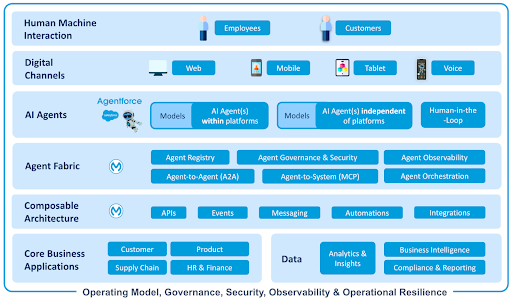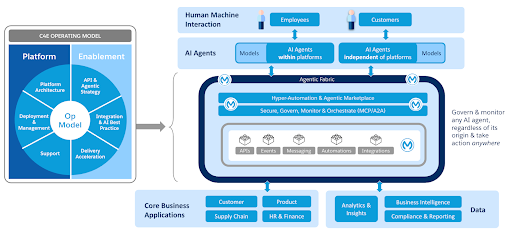The enterprise is changing. Across industries, enterprises are evolving from systems that simply respond to systems that act intelligently, autonomously, and contextually. The shift from traditional automation to agentic AI represents more than efficiency. It signals the dawn of digital labour and the emergence of a workforce that reasons, collaborates, and continuously improves.
Forty percent of organizations already have autonomous agents in place, and 41% plan to implement them within the next year. What’s more, experts believe that by 2026, 40% of enterprise applications will feature task-specific AI agents. Together, these insights signal that the agentic era is already well underway.
As with every major technological shift, this moment represents a critical inflection point. The decisions enterprises make now about how they govern and architect AI will determine whether they unlock transformative value or amplify risk and complexity.
Those who embrace this change with the right mindset, technologies, operating model and architecture, become agentic enterprises. By embedding intelligence into the fabric of their operations, these organizations can achieve measurable business benefits.
1. Operational efficiency and cost optimization
- Automate routine, repetitive, or transactional tasks to reduce manual effort and cost-to-serve.
- Increase throughput and responsiveness without proportional growth in headcount.
- Provide 24/7 availability to handle demand surges and maintain consistent service levels.
- Continuously optimize workflows through data-driven learning and feedback loops.
2. Enhanced customer and employee experience
- Deliver instant, consistent, and context-aware responses across all channels.
- Free employees to focus on higher-value, creative, and relationship-driven activities.
- Improve accuracy and relevance by grounding interactions in real-time enterprise data.
- Enhance satisfaction and trust through faster resolutions and more personalized engagement.
3. Accelerated innovation and time-to-value
- Enable rapid experimentation and iteration with minimal friction.
- Shorten deployment cycles through modular, composable agent architectures.
- Create a foundation for safe, governed expansion into broader agentic automation.
4. Competitive advantage, growth, and strategic agility
- Differentiate through superior responsiveness, personalization, and data utilization.
- Unlock new revenue streams by embedding intelligent products and services into the business portfolio.
- Accelerate go-to-market execution through digital labor that personalizes outreach, supports sales, and optimizes marketing in real time.
- Empower business units to adapt quickly to market or customer shifts.
- Scale innovation faster than competitors by leveraging reusable, governed AI capabilities.
- Build a sustainable advantage through continuous improvement and organizational learning.
The question for leaders is no longer if they should invest in AI, but how to architect their organizations to capture these benefits safely and sustainably. The answer lies not in another model or algorithm, but in enterprise architecture and through defining an AI strategy and reference architecture blueprint that connects systems, data, processes, and people into an intelligent whole.
This is the foundation of the agentic enterprise: an organization engineered to harness digital labour responsibly, securely, scalably, in a managed and governed way, and in direct alignment with its business outcomes and risk appetite.
Your architecture is your competitive advantage in the agentic era. Let’s explore this in more detail.
Defining the agentic enterprise
The agentic enterprise represents the next phase of digital transformation where AI agents, data, and humans work together to drive business outcomes in real time. Rather than isolated AI pilots or point solutions, the agentic enterprise operationalizes AI through both agentic and composable building blocks that make intelligence reusable and governable across the organization.
To realize these benefits, organizations need a clear architectural blueprint that defines how agents, data, and systems interoperate. The AI Reference Architecture underpinning the agentic enterprise is illustrated below, where success depends on both strong composable and data foundations.

In this model, AI agents can be served through a number of digital channels of engagement where:
- AI agents operate within platforms (e.g. Agentforce) and leverage the full suite of tools, data, functionality, reasoning engine, security, trust layer and resources provided by the platform.
- AI Agents act independently as standalone capabilities (not tied to a specific platform or ecosystem) and can coordinate across systems and data sources to fulfil business goals.
- Human-in-the-loop design keeps control where it belongs (i.e. with people) while composable building blocks ensure every interaction is grounded in trusted data and business logic.
At the heart of this architecture is MuleSoft’s Agent Fabric that seamlessly enables, governs and secures your agent network.
MuleSoft Agent Fabric: The engine of the agentic enterprise
MuleSoft’s Agent Fabric is a key capability designed to seamlessly enable agent-to-agent and agent-to-system interactions. Built on MuleSoft’s proven strengths in integration, APIs, and automation, Agent Fabric provides the key capabilities required to operationalise agentic AI at enterprise scale:
- Agent Registry: a central location to catalog every enterprise agentic asset to enable developers and agents to discover and reuse.
- Agent Governance and Security: a key foundation to secure, inspect, and manage every agent-to-agent and agent-to-system interaction. For example, applying enterprise policies such as PII detection, toxic data filtering, and other compliance rules consistently across all agents.
- Agent Orchestration: a context-aware routing service that continuously discovers and engages the best-fit agents and assets, ensuring complex processes execute seamlessly, securely, and with consistent quality.
- Agent Observability: provides a visual map of your agent network and associated domains to shows how agents are interacting across the service-chain.
Together, these capabilities make MuleSoft’s Agent Fabric the key foundation for safe, scalable agentic automation by bridging composable architecture, governed data, and AI orchestration in one unified platform.
MuleSoft’s Agent Fabric builds on proven composable integration foundations to extend orchestration and governance into the AI layer. This ensures agentic systems operate with the same trust, visibility, and control that enterprises expect from their integrations today. Emerging frameworks such as Model Context Protocol (MCP) and Agent-to-Agent (A2A) are accelerating this shift by providing a standard for connecting AI agents with enterprise data and services, as well as connecting AI agents with other agents across the agent ecosystem.
Through this foundation, organizations can:
- Rapidly expose and reuse agentic capabilities across lines of business
- Connect AI models directly to enterprise systems with full governance and control
- Enable digital labor to orchestrate outcomes rather than isolated tasks
- Scale agentic innovation without compromising compliance or security
Composable architecture: The agentic intelligence enabler
If agentic AI represents the what, the composable architecture represents the how.
Behind every adaptive, intelligent enterprise lies a foundation designed for agility and that enables digital labor to act with speed, accuracy, and context. This is the role of composable architecture, i.e. to abstract business capabilities into modular, API-driven and automation-driven components that can be rapidly assembled, reused, or reconfigured to meet new demands.
In the context of agentic AI, this means:
- APIs expose enterprise capabilities for agents to consume securely and consistently
- Events enable near-realtime awareness and responsiveness to business changes
- Integrations connect data and processes across systems, eliminating silos
- Automations orchestrate workflows between human and digital workers
The composable architecture is what allows AI agents to act by giving them access to the right data, context, and governance at the moment of decision, ensuring their actions align with enterprise policy and strategy.
Data is the fuel for agentic success
If composable architecture provides the nervous system of the agentic enterprise, data is its lifeblood. Without trusted, accessible, and contextually rich data, even the most capable AI agents remain blind and unable to make intelligent or compliant decisions.
Agentic AI thrives on composable data, data that is discoverable, reusable, and served through well-governed interfaces. This doesn’t just mean having a modern data platform; it means having the right data available in the right context, at the right time, and with the right guardrails.
Enterprises that achieve this are seeing measurable results:
- Higher accuracy and reliability as agents reason over complete, up-to-date information
- Faster decision cycles driven by real-time data flows and event-driven triggers
- Improved compliance and traceability through governed data access and lineage
- Greater innovation as composable data products can be reused across multiple agentic use cases
MuleSoft plays a pivotal role here by connecting and exposing data from across the enterprise through APIs, events, and secure integrations. Organisations can use MuleSoft to access data regardless of where it is stored and this means giving AI agents and business systems the information they need with embedded governance and security.
This approach supports both data fabric and data mesh strategies, allowing information to remain distributed while still being orchestrated coherently. As a result, enterprises can achieve ‘semantic interoperability’, a state where data is not just available, but meaningful and actionable to AI agents.
In an agentic enterprise, data becomes more than an asset. It becomes an active participant in decision-making, adaptation, and continuous improvement. It’s what transforms AI from insight into impact.
Operating model for the agentic enterprise
Technology alone doesn’t create an agentic enterprise. An effective, federated operating model is required to balance innovation with frictionless governance to ensure AI is deployed safely, consistently, and at scale.
Agentic transformation demands an evolution in how organizations operate to blend empowerment with responsible control. The ideal model is federated in execution but centralized in governance. This allows teams to innovate and deploy agentic solutions autonomously across enterprise domains, while a frictionless governance framework ensures consistency, compliance, and trust across the enterprise.
This is the natural progression of the MuleSoft Center for Enablement (C4E) reimagined for an AI-driven era. Where the C4E enabled composable delivery at scale, its evolution empowers agentic centers for enablement, balancing agility with oversight through shared standards, reusable assets, and continuous learning. This is reflected in the figure below, whereby the C4E operating model for composability can evolve into one which spans the AI agent network.

An effective C4E operating model is needed to be successful with both composability and agentic AI. Leading organizations are embedding four pillars into this evolved model:
- Federated delivery: Empowering domains to innovate and deploy agents safely within a consistent enterprise framework
- Centralized, frictionless governance: Ensuring ethical, compliant, and observable AI operations without slowing down innovation
- Capability uplift: Equipping teams to design, collaborate with, and monitor the use of AI Agents effectively
- Operational Resilience: Embedding observability and feedback loops to manage and optimise agentic performance
When these elements come together, the result is an operating model built for scale, trust, agility, and one that turns agentic AI from experimentation into a core business capability.
4 steps to becoming an agentic enterprise
Becoming an agentic enterprise is a strategic journey. Success comes from building the right foundations, establishing the right governance, and scaling innovation with confidence. For organizations ready to move from experimentation to enterprise value, four steps can accelerate the journey.
- Establish composable and data foundations: Connect your ecosystem through APIs, events, and governed data access. Build composability into your architecture so AI can act with context and integrity.
- Define your AI reference architecture: Align business and IT perspectives around a shared architecture blueprint that outlines how data, integration, and governance come together to support agentic use cases.
- Start with high-value, low-risk use cases: Identify where digital labor can deliver measurable benefit, from employee productivity and customer experience to operational optimisation. Demonstrate value quickly to build trust and momentum.
- Scale through federated enablement and governance: Evolve your operating model into a C4E to provide a federated model for AI adoption. Empower domains to innovate locally, while maintaining centralised, frictionless oversight to ensure safety, consistency, and compliance against your AI strategy, principles and standards.
The journey to becoming an agentic enterprise begins with an architectural vision, underpinned with the right technologies, that unites innovation, data, and governance to deliver business outcomes at scale.
Architecting intelligence for business outcomes
The rise of agentic AI marks a new chapter in digital transformation and one where intelligence becomes operational, embedded into the very fabric of how the enterprise works. Yet this transformation doesn’t start with algorithms or platforms; it starts with architecture.
By combining composable design, governed data, and a federated operating model, organizations can create the conditions for digital labor to thrive safely and at scale. Agent Fabric provides the key backbone for this evolution by connecting agents, systems, and humans through an intelligent, governed fabric that operationalises AI across the enterprise.
The agentic enterprise can be built today with MuleSoft’s leadership in composability coupled with the unique capabilities of Agent Fabric. By partnering with MuleSoft, you can ensure your transformation journey to an agentic enterprise is well-guided, grounded in architecture best practice and delivers measurable business outcomes.
Those who embrace the right technologies and architect for intelligence today will lead in delivering their organizations’ strategic agentic outcomes of tomorrow.









